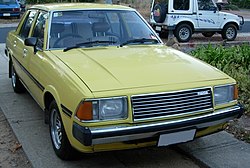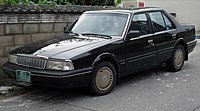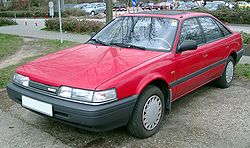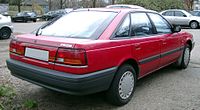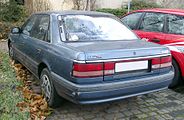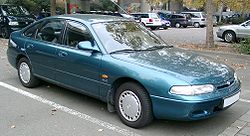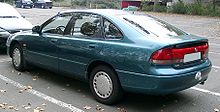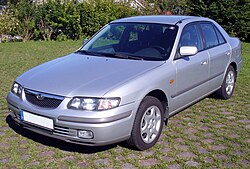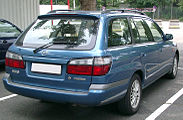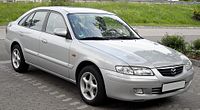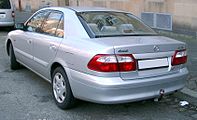Mazda 626
| Mazda 626 | |
|---|---|
| Production period: | 1979-2002 |
| Class : | Middle class |
| Body versions : | Sedan , hatchback , station wagon , coupe |
| Previous model: | Mazda 616/618 |
| Successor: | Mazda6 |
The Mazda 626 was a passenger car model from the Japanese manufacturer Mazda . It was based on the manufacturer's model offered in Japan under the name Mazda Capella .
The 626 represented the mid- range model in the group's product line . It was manufactured from the beginning of 1979 and replaced by the Mazda6 in the summer of 2002 .
The Mazda 626 was sold in Asia , Australia and South Africa with a revised body also under the name Ford Telstar , which was based on the economic participation of the Ford Motor Company in the Japanese manufacturer Mazda.
626 / Capella (CB2, 1979–1982)
| 1st generation | |
|---|---|
|
Mazda 626 notchback (1979–1982) |
|
| Production period: | 1979-1982 |
| Body versions : | Limousine , coupe |
| Engines: |
Petrol engines : 1.6–2.0 liters (55–66 kW) |
| Length: | 4304 mm |
| Width: | 1660 mm |
| Height: | 1345-1370 mm |
| Wheelbase : | 2510 mm |
| Empty weight : | 995-1165 kg |
In October 1978 Mazda presented the Capella or 626, which was introduced in early 1979 with rear-wheel drive in most markets. He came to Germany from February 1979.
The first generation of the Mazda 626 was produced as a sedan and a coupe , each with a notchback . It was optionally available with a 1.6-liter engine with 55 kW (75 hp) and a 2.0-liter engine with an output of 66 kW (90 hp), in Japan also with a 1.8-liter -Four cylinder. German prices started at DM 12,690 for the 1.6-liter sedan; the two-liter cost 1000 DM, the coupe 300 DM more each.
One innovation was the split, foldable rear bench seat. In the USA , Mazda sales doubled after the introduction of the Mazda 626. The 626 was also a great sales success in Europe. This first generation was produced until 1982.
In November 1980 the 626 received a smoother front section with flush headlights and detailed improvements to technology and equipment; the five-speed gearbox was now also standard on the 1600.
The 626 was offered in Germany with the following engine variants:
| model | Displacement | Valves | power | Max. Torque |
|---|---|---|---|---|
| 1.6 | 1568 cc | 8th | 55 kW (75 PS) | 120 Nm at 3800 rpm |
| 2.0 | 1970 cc | 8th | 66 kW (90 PS) | 159 Nm at 2500 rpm |
| Mazda 626: | 1600 (EU) | 1800 (Japan) | 2000 (EU) |
|---|---|---|---|
| Engine: | 4-cylinder in-line engine (four-stroke), front | ||
| Displacement: | 1586 cc | 1769 cc | 1970 cc |
| Bore × stroke: | 78 × 83 mm | 80 × 88 mm | 80 × 98 mm |
| Performance at 1 / min: | 55 kW (75 PS) at 5500 |
73.5 kW (100 SAE PS) at 6000 |
66 kW (90 PS) at 4800 |
| Max. Torque at 1 / min: | 120 Nm at 3800 | 149 Nm at 4000 | 159 Nm at 2500 |
| Compression: | 8.6: 1 | ||
| Mixture preparation: | a downdraft twin carburetor | ||
| Valve control: | hanging valves (overhead camshaft, chain), light alloy cylinder head | ||
| Cooling: | Water cooling | ||
| Transmission: | 4- or 5-speed gearbox aW three-speed automatic rear-wheel drive |
||
| Front suspension: | Strut axle, lower wishbones, coil springs, stabilizer | ||
| Rear suspension: | Rigid axle, trailing arm, Panhard rod , coil springs, stabilizer | ||
| Body: | Sheet steel, self-supporting | ||
| Track width front / rear: | 1370/1380 mm | ||
| Wheelbase: | 2510 mm | ||
| Dimensions: | 4305 (USA: 4415) x 1660 x 1345-1370 mm | ||
| Empty weight: | 1045 kg USA: 1165 kg |
995-1020 kg | 1060 kg |
| Maximum speed (factory): | 160-165 km / h | 165 km / h | 170-175 km / h |
| 0-100 km / h (factory): | 13.5 s | n / A | 11.3 s |
| Consumption (liters / 100 km, DIN): | 8.8 N | approx. 8-13 | 9.1 N |
| Price: | from DM 12,690 (02/79) | - | from DM 13,690 (02/79) |
626 / Capella (GC, 1982-1987)
| 2nd generation | |
|---|---|
|
Mazda 626 notchback (1982–1987) |
|
| Production period: | 1982-1987 |
| Body versions : | Sedan , station wagon , coupé |
| Engines: |
Otto engines : 1.6–2.0 liters (60–88 kW) Diesel engines : 2.0 liters (47 kW) |
| Length: | 4430-4516 mm |
| Width: | 1690 mm |
| Height: | 1350-1395 mm |
| Wheelbase : | 2510 mm |
| Empty weight : | 990-1160 kg |
At the end of 1982 Mazda launched the front-wheel drive 626 . The car magazines Motor Trend and Wheels magazine voted the 626 the "Import Car of the Year 1983". The new 626 was equipped in the LX version with a 1.6-liter engine with 60 kW (82 hp) and in the GLX version with a 2.0-liter engine with 75 kW (102 hp) (Germany ). In Switzerland only the 2.0 liter engine was available, which due to different environmental regulations only developed 70 kW (95 hp). The car was available as a four-door notchback, five-door hatchback and two-door coupe, each in the LX and GLX variants.
In some other European countries, for example in France, the LX version with the large engine and the GLX version with the small engine were also available. The GLX was very well equipped for European standards at the time. It had extras as standard, such as four power windows (electrically operated rear vent windows on the Coupé), velor upholstery and central locking. These options were then even luxury cars mostly extra charge. In 1983, when the 626 was first sold, only metallic paint and power steering in conjunction with the 2.0-liter engine were optional.
Externally, the 2.0-liter version differed - regardless of the equipment variant - through larger rims (14 inches instead of 13 inches) with fully decorative wheel covers, wider tires (185/70 HR 14 instead of 165 SR 13) and a glued-on side Decorative stripes from the 1.6 liter model. From 1984 a diesel model was also offered with a 2.0-liter engine and 47 kW (64 hp).
From the beginning of 1986, Mazda also offered a GT version with a 2.0-liter engine and manifold injection after a revision of the model series . This had an output of 88 kW (120 hp) and, as additional equipment, a cruise control (tempomat). A catalytic converter variant (2.0i Kat) with 66 kW (90 PS) was also introduced. A 2.0-liter engine with 47 kW (64 PS) was still available as a diesel drive. A sedan with a notchback and four doors, a sedan with a hatchback and five doors and a coupé with two doors were still available as body variants . The 2.0 l engine with 88 kW could be combined with any body variant. With the revision, the 1.6-liter engine for the coupé was no longer required.
The 626 was now offered with the following engine variants:
| model | Displacement | Cylinders / valves | power | Max. Torque |
|---|---|---|---|---|
| 1.6 LX | 1576 cc | 4/8 | 60 kW (82 hp) at 5500 rpm | 122 Nm at 3800 rpm |
| 2.0i GLX ( catalytic converter ) |
1984 cc | 4/8 | 66 kW (90 PS) at 5000 rpm | 153 Nm at 2500 rpm |
| 2.0 GLX | 1984 cc | 4/8 | 75 kW (102 PS) 1 at 5600 rpm | 159 Nm at 3700 rpm |
| 2.0i GT | 1984 cc | 4/8 | 88 kW (120 PS) at 5400 rpm | 171 Nm at 4000 rpm |
| diesel | ||||
| 2.0 LX diesel | 1998 cc | 4/8 | 47 kW (64 PS) at 4650 rpm | 120 Nm at 2750 rpm |
Kia Concord / Capital
From 1987 Kia Motors took over the production facilities and built the model under license as the Kia Concord with Mazda petrol engines (from two liters displacement) and the 2.0-liter diesel engine. In 1989 the Kia Capital was added, which was equipped with the 1.5-liter petrol engine and was supposed to be a cheaper alternative.
In 1991 it received a facelift and now had the 1.8-liter engine, which was no longer offered in the Concord.
1995 Kia ended the production of the Concord, whose position the Kia Credos took as its successor. The Capital expired in 1996. The segment was henceforth occupied by the Kia Sephia .
626 / Capella (GD / GV, 1987–1992)
| 3rd generation | |
|---|---|
|
Mazda 626 hatchback (1987-1992) |
|
| Production period: | 1987–1992 (station wagon: 1988–1997) |
| Body versions : | Sedan , hatchback , station wagon , coupe |
| Engines: |
Otto engines : 2.0–2.2 liters (66–103 kW) Diesel engines : 2.0 liters (44 kW) |
| Length: | 4554 mm |
| Width: | 1689 mm |
| Height: | 1410 mm |
| Wheelbase : | 2515-2575 mm |
| Empty weight : | 1125-1360 kg |
In August 1987 the new 626 model was presented in the world press. The new Mazda 626 came on the German market in October 1987. This was available as a step and hatchback sedan , as a coupé and from summer 1988 in Germany also as a station wagon , which was continued to be built in parallel with the successor until summer 1997 after the sedan was replaced in spring 1992.
The familiar 2.0-liter gasoline engines were used again. In the LX as a 2.0 liter with carburettor and 66 kW (90 PS) with an unregulated catalytic converter, in the GLX as a 2.0i with a regulated 3-way catalytic converter and also 66 kW (90 PS). For the 1990 model year, the LX also became the 2.0i with a regulated 3-way catalytic converter, so that from now on there were only differences in the equipment. There was also the vehicle with the 2.2i-12V with 85 kW (116 PS) in the GLX variant and as the 2.0i-16V with 103 kW (140 PS) as the GT variant. In Germany, the 2.0L-12V with 79 kW (107 PS) was only on the market for a short time because it had no catalytic converter and was more expensive to maintain due to the vehicle taxation at the time. The GT variant was also only available as a 4-door notchback for a very short time (up to model year 1989). There was also a 2.0-liter diesel with 44 kW (60 hp).
For the 1990 model year, the 626 2.2i 12V was also sold as a 4WD all-wheel drive vehicle and ABS could be ordered at an additional cost. In Japan the model was sold as a Capella and was produced until 1996. There was a version with a 5-speed manual transmission and a version with a 4-speed automatic transmission.
The third generation was the most successful in Germany. No import model in the middle class sold better. In addition, the car was the best-selling import car in 1988 and 1989. No other Japanese vehicle has ever achieved this.
This 626 is the first Japanese vehicle to win a comparison test in Auto, Motor und Sport magazine . In the test (issue 21/1987) the vehicle was compared with the competitors Audi 80 , Peugeot 405 , Renault 21 and Ford Sierra in May 1987 .
For this series, the system called 4WS was available for the first time from Mazda in the GT equipment variant. It provided improved cornering stability by steering the rear wheels towards the front wheels depending on the speed.
Technical specifications
| 2.0 | 2.0i | 2.0-12V | 2.0i-16V | 2.2i-12V | 2.2i-12V turbo | 2.0 diesel | 2.0 Diesel Comprex | ||
|---|---|---|---|---|---|---|---|---|---|
| Construction period | 10.1987-01.1990 | 10.1987-07.1997 | 10.1987-12.1988 | 10.1987-07.1991 | 10.1987-07.1991 | ||||
| Engine characteristics | |||||||||
| Engine type | R4 petrol engine | R4 diesel engine | |||||||
| Number of valves per cylinder | 2 | 3 | 4th | 3 | 2 | ||||
| Valve control | OHC , timing belt | DOHC, timing belt | OHC, timing belt | ||||||
| Mixture preparation | Carburetor | Manifold injection | Carburetor | Manifold injection |
Swirl chamber injection |
||||
| Engine charging | - | turbocharger | - | Comprex loader | |||||
| cooling | Water cooling | ||||||||
| Bore × stroke | 86.0 mm × 86.0 mm | 86.0 mm × 94.0 mm | 86.0 mm × 86.0 mm | ||||||
| Displacement | 1998 cc | 2184 cc | 1998 cc | ||||||
| Compression ratio | 8.6: 1 | 10.0: 1 | 9.5: 1 | 8.6: 1 | 22.7: 1 | ||||
| Max. Power at 1 / min |
66 kW (90 PS) / 5200 |
66 kW (90 PS) / 5000 |
79 kW (107 PS) / 5300 |
103 kW (140 PS) / 6000 |
85 kW (115 PS) / 5000 |
108 kW (147 PS) / 4300 |
44 kW (60 PS) / 4000 |
60 kW (82 PS) / 4000 |
|
| Max. Torque at 1 / min |
150 Nm / 3400 |
153 Nm / 2500 |
162 Nm / 3300 |
173 Nm / 4000 |
180 Nm / 3900 |
258 Nm / 3500 |
119 Nm / 2750 |
181 Nm / 2000 |
|
| Power transmission | |||||||||
| Drive, as standard | Front wheel drive | ||||||||
| Drive, optional | - | all wheel drive | - | ||||||
| Gearbox, as standard | 5-speed manual transmission | ||||||||
| Gearbox, optional | - | 4- speed automatic transmission | - | ||||||
| Readings | |||||||||
| Top speed | 176 km / h | 175 km / h | 186 km / h | 204 km / h | 189 km / h | 225 km / h | 152 km / h | - | |
| Fuel consumption over 100 km (combined) | 8.8 l N | 8.5 l N | 8.1 l p | 8.8 l S | 8.5 l N | 8.5 l S | 6.4 l D | 6.2 l D | |
- The availability of the engines depended on the model, equipment and market.
626 / Capella / Cronos (Efini MS6 GE, 1992–1997)
| 4th generation | |
|---|---|
|
Mazda 626 hatchback (1992-1997) |
|
| Production period: | 1992-1997 |
| Body versions : | Limousine , station wagon |
| Engines: |
Otto engines : 1.8–2.5 liters (66–121 kW) Diesel engines : 2.0 liters (55 kW) |
| Length: | 4695 mm |
| Width: | 1750 mm |
| Height: | 1390 mm |
| Wheelbase : | 2610 mm |
| Empty weight : | 1175 kg |
The Mazda 626, presented in early 1992 as a hatchback and notchback sedan, has been heavily revised. At the same time, the third-generation station wagon variant was still available, while the coupé was discontinued. Instead, Mazda presented the Mazda MX-6 , which was built on the floor pan of the Mazda 626 and whose technology was also installed in the Ford Probe . The sedan was offered in Japan under the name Mazda Cronos . With a little more luxurious equipment, the model was also available in Japan as a Ẽfini .
The car was given a sportier appearance, which was not very well received by the more conservative target group. The hatchback sedan in particular, with a rear spoiler integrated into the tailgate, took some getting used to. The car was too big and too expensive for its class for its class at the time, which meant that this generation of models was not a great sales success.
The four-wheel steering 4WS was installed for the last time in this series. It was also used in the MX-6 .
Technical specifications
| 1.9i | 2.0i | 2.5i V6 | 2.0 diesel | |||
|---|---|---|---|---|---|---|
| Construction period | 10.1994-04.1997 | 01/1992-04/1997 | ||||
| Engine characteristics | ||||||
| Engine identification | FP | FS | KL-DE | RF | ||
| Engine type | R4 petrol engine | V6 petrol engine | R4 diesel engine | |||
| Number of valves per cylinder | 4th | 2 | ||||
| Valve control | DOHC , timing belt | 2 × DOHC, gears / toothed belts |
OHC, timing belt | |||
| Mixture preparation | Manifold injection |
Swirl chamber injection |
||||
| Engine charging | - | Pressure wave supercharger | ||||
| cooling | Water cooling | |||||
| Bore × stroke | 83.0 mm × 85.0 mm | 83.0 mm × 92.0 mm | 84.5 mm x 74.2 mm | 86.0 mm × 86.0 mm | ||
| Displacement | 1840 cc | 1991 cc | 2497 cc | 1998 cc | ||
| Compression ratio | 9.6: 1 | 9.0: 1 | 9.2: 1 | 21.1: 1 | ||
| Max. Power at 1 / min |
66 kW (90 PS) / 5500 |
77 kW (105 PS) / 5500 |
85 kW (115 PS) / 5500 |
121 kW (165 PS) / 5600 |
55 kW (75 PS) / 4000 |
|
| Max. Torque at 1 / min |
143 Nm / 2500 |
155 Nm / 4300 |
170 Nm / 4500 |
217 Nm / 4800 |
169 Nm / 2000 |
|
| Power transmission | ||||||
| Drive, as standard | Front wheel drive | |||||
| Drive, optional | - | all wheel drive | - | |||
| Gearbox, as standard | 5-speed manual transmission | |||||
| Gearbox, optional | - | 4- speed automatic transmission | - | |||
| Readings | ||||||
| Top speed | 181 km / h | 191 km / h | 198 km / h (185 km / h) |
220 km / h (207 km / h) |
161 km / h | |
| Acceleration, 0-100 km / h | 12.6 s | 11.9 s | 10.9 s (13.4 s) |
8.5 s (10.2 s) |
14.7 s | |
| Fuel consumption over 100 km (combined) | 7.9 l p | 7.7 l S (8.1 l S) |
8.8 l S (9.4 l S) |
7.0 l D | ||
- ↑ Values in round brackets ("()") for automatic transmissions.
- The availability of the engines depended on the model, equipment and market.
626 / Capella (GF / GW, 1997-2002)
| 5th generation | |
|---|---|
|
Mazda 626 notchback (1997-1999) |
|
| Production period: | 1997-2002 |
| Body versions : | Sedan , hatchback , station wagon |
| Engines: |
Otto engines : 1.8–2.5 liters (66–147 kW) Diesel engines : 2.0 liters (74–81 kW) |
| Length: | 4575-4660 mm |
| Width: | 1710 mm |
| Height: | 1430-1515 mm |
| Wheelbase : | 2610 mm |
| Empty weight : | 1245-1535 kg |
From April 1997, the fifth generation 626 was the last model with this designation. A notchback and a hatchback sedan (GF) were again available as body variants, to which a new station wagon (GW) was added from January 1998. In contrast to the previous model, this station wagon was, like the sedans, a new development.
In December 1999 there was a facelift for the hatchback and notchback sedan, which was also carried out for the station wagon in February 2000. These versions differ from the first version primarily through a new exterior design and a further optimized interior.
The notchback and hatchback sedans as well as the station wagon versions are available in three configurations and with different engines. The three petrol engines offered are based on four-cylinder engines with multi-valve technology, with the basic engine having a displacement of 1.9 l and a maximum engine output of 66 kW (90 hp), later 74 kW (101 hp). The other two engines have 2 l with 85 kW (115 PS) or 100 kW (136 PS).
Instead of the equipment variants ( LX , GLX , GT ) equipment lines were now offered. These equipment lines were designated as Comfort , Spirit , Exclusive and Sportive . In the Sportive equipment line , only the 2.0-liter engine with 100 kW (136 hp) was offered.
Technical specifications
| 1.9 | 2.0 | 2.0 HP | 2.5 | 2.0 DITD | |||
|---|---|---|---|---|---|---|---|
| Construction period | 04.1997-12.1999 | 12.1999-08.2002 | 04.1997-08.2002 | 04.1998-10.2000 | 10.2000-08.2002 | ||
| Engine characteristics | |||||||
| Engine type | R4 petrol engine | V6 petrol engine | R4 diesel engine | ||||
| Number of valves per cylinder | 4th | ||||||
| Valve control | DOHC , timing belt | DOHC, gears / timing belts |
OHC, timing belt | ||||
| Mixture preparation | Manifold injection | Direct injection | |||||
| Engine charging | - | Turbocharger , intercooler | |||||
| cooling | Water cooling | ||||||
| Bore × stroke | 83.0 mm × 85.0 mm | 83.0 mm × 92.0 mm | 84.5 mm x 74.2 mm | 86.0 mm × 86.0 mm | |||
| Displacement | 1840 cc | 1991 cc | 2497 cc | 1998 cc | |||
| Compression ratio | 9.6: 1 | 9.7: 1 | 10.0: 1 | 18.8: 1 | |||
| Max. Power at 1 / min |
66 kW (90 PS) / 5000 |
74 kW (101 PS) / 5500 |
85 kW (115 PS) / 6000 |
100 kW (136 PS) / 5800 |
147 kW (200 PS) / 6500 |
74 kW (101 PS) / 4000 |
81 kW (110 PS) / 4000 |
| Max. Torque at 1 / min |
147 Nm / 2500 |
152 Nm / 4000 |
173 Nm / 4500 |
181 Nm / 4500 |
224 Nm / 4800 |
220 Nm / 1800 |
230 Nm / 1800 |
| Power transmission | |||||||
| drive | Front wheel drive | all wheel drive | Front wheel drive | ||||
| Gearbox, as standard | 5-speed manual transmission | 4- speed automatic transmission | 5-speed manual transmission | ||||
| Gearbox, optional | 4-speed automatic transmission | - | 4-speed automatic transmission | - | |||
| Measured values (limousine) | |||||||
| Top speed | 180 km / h | 182 km / h | 198 km / h (185 km / h) |
208 km / h (195 km / h) |
(220 km / h) | 185 km / h | 191 km / h |
| Acceleration, 0-100 km / h | 12.6 s | 11.8 s | 9.9 s (12.0 s) |
9.6 s | k. A. | 11.5 s | 11.0 s |
| Measured values (combi) | |||||||
| Top speed | 178 km / h | 180 km / h | 192 km / h (179 km / h) |
202 km / h (189 km / h) |
k. A. | 175 km / h | 185 km / h |
| Acceleration, 0-100 km / h | 12.9 s | 12.0 s | 10.6 s (12.1 s) |
10.5 s | k. A. | 13.5 s | 12.0 s |
- The availability of the engines depended on the model, equipment and market.
Weak points
- According to the DAT / VDA list, the models with gasoline engines are not E10 compatible.
- The rust prevention is partially inadequate. Corrosion can often be seen on the folds of the bonnet, the rear strut domes and the rear wheel arches.
End of production
On August 30, 2002, the last Mazda 626 rolled off the assembly line. The successor model has been called Mazda6 since then .
literature
- Automobile revue . Catalog numbers 1979, 1984, 1997, 2000 and 2001.
- Car catalog 1988/89. Stuttgart, August 1, 1988.
- Joachim Kuch: Japanese automobiles . Motorbuch Verlag, Stuttgart 1990, ISBN 3-613-01365-7 , pp. 85-90.
- HR Etzold : Mazda 626 - This is how it's done . Delius Klasing Verlag, 2004.
Web links
- Former official website ( Memento of February 11, 2001 in the Internet Archive )
Individual evidence
- ↑ E10 compatibility of motor vehicles ( Memento of the original from May 11, 2011 in the Internet Archive ) Info: The archive link was inserted automatically and has not yet been checked. Please check the original and archive link according to the instructions and then remove this notice. As of December 1, 2011. Accessed May 11, 2014.
